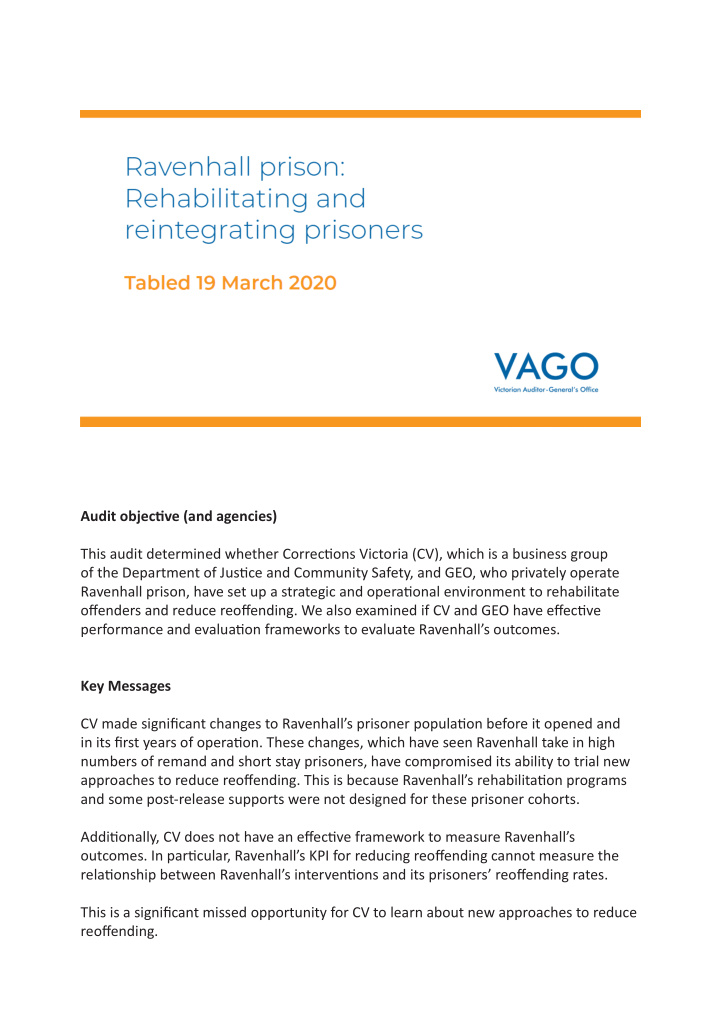



Audit objectjve (and agencies) This audit determined whether Correctjons Victoria (CV), which is a business group of the Department of Justjce and Community Safety, and GEO, who privately operate Ravenhall prison, have set up a strategic and operatjonal environment to rehabilitate ofgenders and reduce reofgending. We also examined if CV and GEO have efgectjve performance and evaluatjon frameworks to evaluate Ravenhall’s outcomes. Key Messages CV made signifjcant changes to Ravenhall’s prisoner populatjon before it opened and in its fjrst years of operatjon. These changes, which have seen Ravenhall take in high numbers of remand and short stay prisoners, have compromised its ability to trial new approaches to reduce reofgending. This is because Ravenhall’s rehabilitatjon programs and some post-release supports were not designed for these prisoner cohorts. Additjonally, CV does not have an efgectjve framework to measure Ravenhall’s outcomes. In partjcular, Ravenhall’s KPI for reducing reofgending cannot measure the relatjonship between Ravenhall’s interventjons and its prisoners’ reofgending rates. This is a signifjcant missed opportunity for CV to learn about new approaches to reduce reofgending.
Context: Ravenhall Ravenhall is Victoria’s newest prison and began receiving prisoners in November 2017. It was designed to trial new rehabilitatjon methods to reduce reofgending. These methods include a suite of programs and supports to reduce reofgending and help prisoners reintegrate into the community. GEO’s contract with the state includes fjnancially incentjvised KPIs. In our audit, we focused on KPI 15, which measures Ravenhall’s reintegratjon results, and KPI 16, which measures its prisoners’ reofgending rates. Findings: Contract changes Ravenhall was initjally designed to accommodate 1 000 sentenced male prisoners. However, CV changed its contract to accommodate growing prisoner numbers across the state. These changes included increasing Ravenhall’s capacity to 1 300 and introducing remand prisoners to its cohort, who now make up 52% of its populatjon. CV has plans to further increase Ravenhall’s total number of prisoners. Ravenhall also has a high proportjon of short-stay prisoners. As most of Ravenhall’s prisoners are remand or short-stay, many are ineligible to partjcipate in its criminogenic programs, which focus on reducing reofgending. Findings: Performance, monitoring and evaluatjon Ravenhall is the fjrst Australian prison to have KPIs and payments linked to its reintegratjon and reofgending outcomes. KPI 16, which measures reofgending rates, is not a suitable KPI for determining fjnancial payments. This KPI is insensitjve to how much infmuence Ravenhall’s programs have on its prisoners’ reofgending rates. It does not consider the amount of tjme a prisoner spends at Ravenhall compared to other Victorian prisons. It also cannot measure if a prisoner’s reofgending outcome has been infmuenced by Ravenhall’s programs or other external factors. Beyond these KPIs, CV has no evaluatjon or research projects planned to examine the relatjonship between Ravenhall’s interventjons and its reofgending outcomes. This means that CV will not know what is or isn’t working with Ravenhall’s programs, and cannot apply learnings to the broader prison system.
Recommendatjons We recommended that the Department of Justjce and Community Safety: 1. review and revise KPIs 15 and 16 2. develop and implement an evaluatjon framework to assess Ravenhall’s reofgending outcomes 3. advise government on the costs and benefjts of Ravenhall’s cohort mix.
Recommend
More recommend